![]()
MENU
BADGES
ORNAMENTATION
Arrowhead Patch
Belt
Buttons
Cap Insignia
Collar Ornaments
Hat
![]() Hatband & Straps
Hatband & Straps
Law Enforcement Insignia
Length-of-Service Insignia
Nametags
Sleeve Brassards
Tie Ornaments & Pins
Miscellaneous
Conclusion
Photofile
Appendix
Bibliography
Notes

BADGES and UNIFORM ORNAMENTATION
of the NATIONAL PARK SERVICE
ORNAMENTATION: Hatband & Straps
|
Through the 1920's, ranger hatbands were either the plain grosgrain bands that came with the hat or individualistic replacements by the rangers. At the San Francisco National Park Conference in 1928, the subject of a special band for the ranger hats was brought to the floor for discussion. One design was submitted (description unknown), and another proposed design included a "pressed" style of hatband. There was considerable criticism of the Sequoia cone because it was significant to California alone. It was felt that the design should be more emblematic of the Park Service as a whole. A ranger on a horse, buffalos, and geometric designs were among the motifs suggested. A pack horse drew the most interest because it dealt with park work and had the essence of the tourist and out-of-doors in it.
At the 1929 superintendents conference at Yellowstone, the Uniform Committee recommended that a band more in keeping with the identity of the National Park Service be adopted for the ranger hat. Chief Landscape Architect Thomas Vint had a sample hatband prepared. This consisted of Sequoia cones and foliage tooled onto a leather band secured at the left side by ring fasteners. The front had a blank space where the name of the park could be impressed, if desired. This was sent to the chairman of the Uniform Committee, Superintendent Owen A. Tomlinson of Mount Rainier, who forwarded it to the director with the committee's recommendation that it be adopted. The committee thought, though, that USNPS should be stamped on the front instead of the park name, which would have to be done by hand and complicate matters at the various parks. The manufacturer of the sample had provided silver acorns as ornaments, but the committee thought that Sequoia cones would be more appropriate. Nickel silver ornaments could be had for fifty cents each in lots of two hundred, and sterling silver for sixty cents. The total cost of the hatband would be $2.10 with the sterling ornaments. [62]
The hatband was approved on January 16, 1930, with the proviso that the sterling ornaments be used. Associate Director Cammerer thought that the added cost of the silver ornaments was "well worth while" and that they should be mandatory. "The hat band is therefore approved with the ornament of the National Park insignia as an integral part of it," he wrote. [63] When estimates were obtained, it was found that the hatbands, with silver ornaments, could be purchased from a manufacturer in San Francisco in lots of 150 for approximately $2.00 each. [64] The sample hatband was returned to Tom Vint, along with the changes required, so he could make a drawing. The drawing incorporated two styles, utilizing the same information. One style had USNPS on the front only, while the other had it on the front and the back. The advantage of the latter was that it would require a die half the size, at considerably less cost, than the former. The die would make two revolutions to imprint the band, instead of the single needed to make the former. The committee thought that, despite the extra cost, the larger die should be used. [65] In order to reduce the cost to the employees, the Service decided to purchase the die and lend it to the successful bidder whenever new hatbands were required. [66] Since the hatband was paid for by the individual, it could be retained after termination of employment. As Acting Director Cammerer stated it: "This hatband is not an emblem of authority such as the Police Badge worn by rangers and other field men, which must be returned in order such emblems of authority will not be scattered promiscuously throughout the country. On the other hand, it is realized that the desire for retention of some souvenir of employment is uppermost in the minds of many, if not most, of the temporary rangers, and by making them pay for the band it will enable them to retain it along with their hats and collar ornaments." [67] The hatbands were to be made out of four-to-five-ounce "Tooling Vealskin," with a two-ounce cinch strap. The Sequoia cone ornaments and the rings were to be sterling silver. Superintendent Tomlinson received the first consignment of hatbands on May 26, 1930. These were made by a Mr. Brown. It is not known if he made the hatbands personally or just represented the company that did. The finished product made such a striking appearance that the first thought was to restrict them to working employees. However, the director had already authorized that they be personal property, and prohibitions that could not be rigidly enforced would only weaken the regulations already in force. [68] So this idea was dropped. New hat bands and cap chin straps were prescribed in the 1936 regulations (Office Order No. 324, April 13, 1936). "Pending approval of a new design and manufacture of a new die" the existing silver Sequoia cone ornaments were to be used. It is not known at this time what the intended changes, if any, were to be to the hat band ornaments. From drawings and photographs, it would appear that the only change in the leather hat band was to widen it from its original 15/16" to 1-1/8". It was recommended that "at least one new hat band be purchased immediately by each field unit so the standard cordovan color prescribed for all leather articles of the National Park Service will be available." [69] | |||
|
|
There was a slight variation in the design in the 1970s, when the manufacturer supplied its own die. These hatbands are made of heavier leather and have a much deeper embossing and the cones have the appearance of pine cones instead of the approved Sequoia cones. With a change of suppliers in the late 1970s the hat band reverted to the original design. Unfortunately, the new bands were of a very inferior quality. They were very thin, with shallow embossing. After a couple of years a new die was cut, and the hatbands once again became something employees could be proud of. With the change of uniform suppliers in the late 1970s or early 1980s the Sequoia cones were changed to gold plate. This was probably to bring them into line with all the other metal on the uniform, which had gravitated to gold over the years. In 1984 they became solid brass. [70] But because the hatbands did not wear out and were usually transferred to new hats, there are still many older rangers sporting the original sterling cones on their hats. Head and chin straps were authorized for the hat in Office Order No. 324 of April 13, 1936. The head strap was to be plain 1/2-inch leather, but the chin strap could be either plain calf-skin or "same design as the hat band," with silver Sequoia fasteners. The 1961 uniform regulations eliminated the chin strap but retained the head strap, although it was now only 1/4-inch wide and to be "worn only in sustained windy conditions." This regulation is still in effect. |
|
|
| ||
Last Modified: Fri, Jan 17 2003 07:08:48 am PDT
http://www.cr.nps.gov/history/online_books/workman1b/voll.htm
![]()


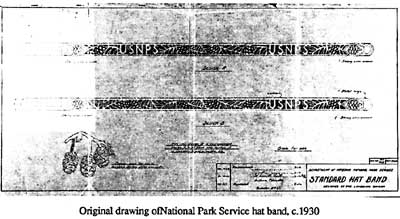
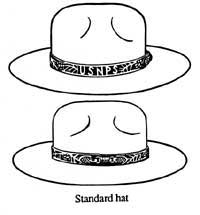
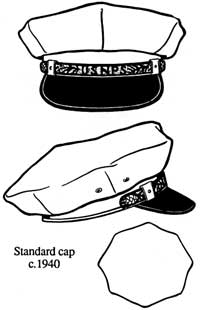
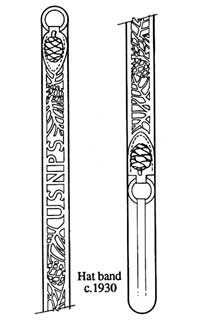
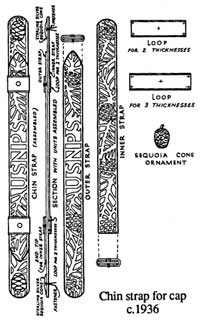
 Top
Top